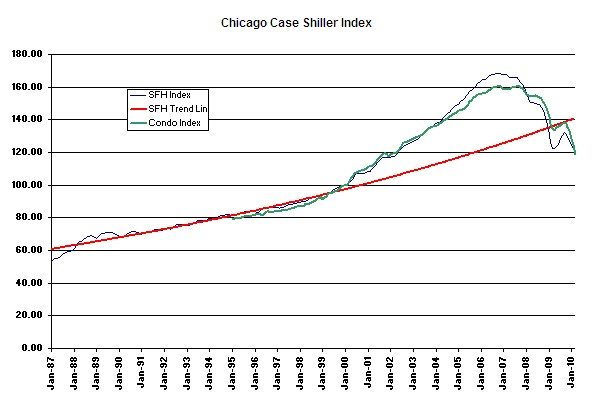estate prices in the US and in the 20 US cities tracked by the Case Shiller home price index. The Gap Gauge builds a trendline based upon the Case Shiller index values prior to 2000, when they believe the housing bubble really took off. Then they measure the “gap” between that trendline and current housing prices as an indicator of whether home prices are rich or cheap. According to the Gap Gauge US home prices have overshot on the downside by 8% in the US and by 37% in Chicago. When they use words like “overshot” and “gap” it sure sounds like “cheap”.
OK, before you get too excited let’s back up a little bit. First of all, who is MacroMarkets and why should we care what they think? MacroMarkets is a company that develops innovative financial instruments that allow ordinary investors to hedge or speculate on the prices of key assets such as homes and oil (All I said is that they develop them; notice that I didn’t say they were successful). Robert Shiller, who helped develop the Case Shiller price index and also coined the term “irrational exuberance”, is one of the founders of MacroMarkets and is also it’s Chief Economist. The MacroMarkets crowd is a pretty clever group, even though their financial products have turned out to be duds, so you have to take them seriously.
So what about this 37% number? Well, you have to take it with a grain of salt. When you look at their Gap Gauge it sure looks like they have the historic growth rate exaggerated a bit (the data doesn’t fit the trendline very well). In fact, I’ve been tracking my own Gap Gauge for the last year (yeah, I beat them to it), which you can see below:
The trendline in my Chicago analysis is based upon data prior to 1999, when I believe the Chicago market began to show signs of a bubble. It turns out that the result is very sensitive to the time period upon which you base your trendline. With my time period I get a much better fit to the historic data and a slower growth rate, which imply that current prices are only 15% below trendline. That’s a big difference, but 15% is still a nice discount.

The MacroMarkets Gap Gauge was released for public use just a few weeks ago, although we (MacroMarkets) and others have used versions of it for a few years. It is a very basic, free (but helpful, we hope) technical analysis tool with a number of simplifying assumptions built-in. The default assumptions are intended for ease of use
Despite my comments above I have a great deal of respect for the MacroMarkets team. I thought their products were brilliant but misunderstood. I personally invested in them and profited nicely from the misunderstandings. I thought they should have been embraced better by investors.